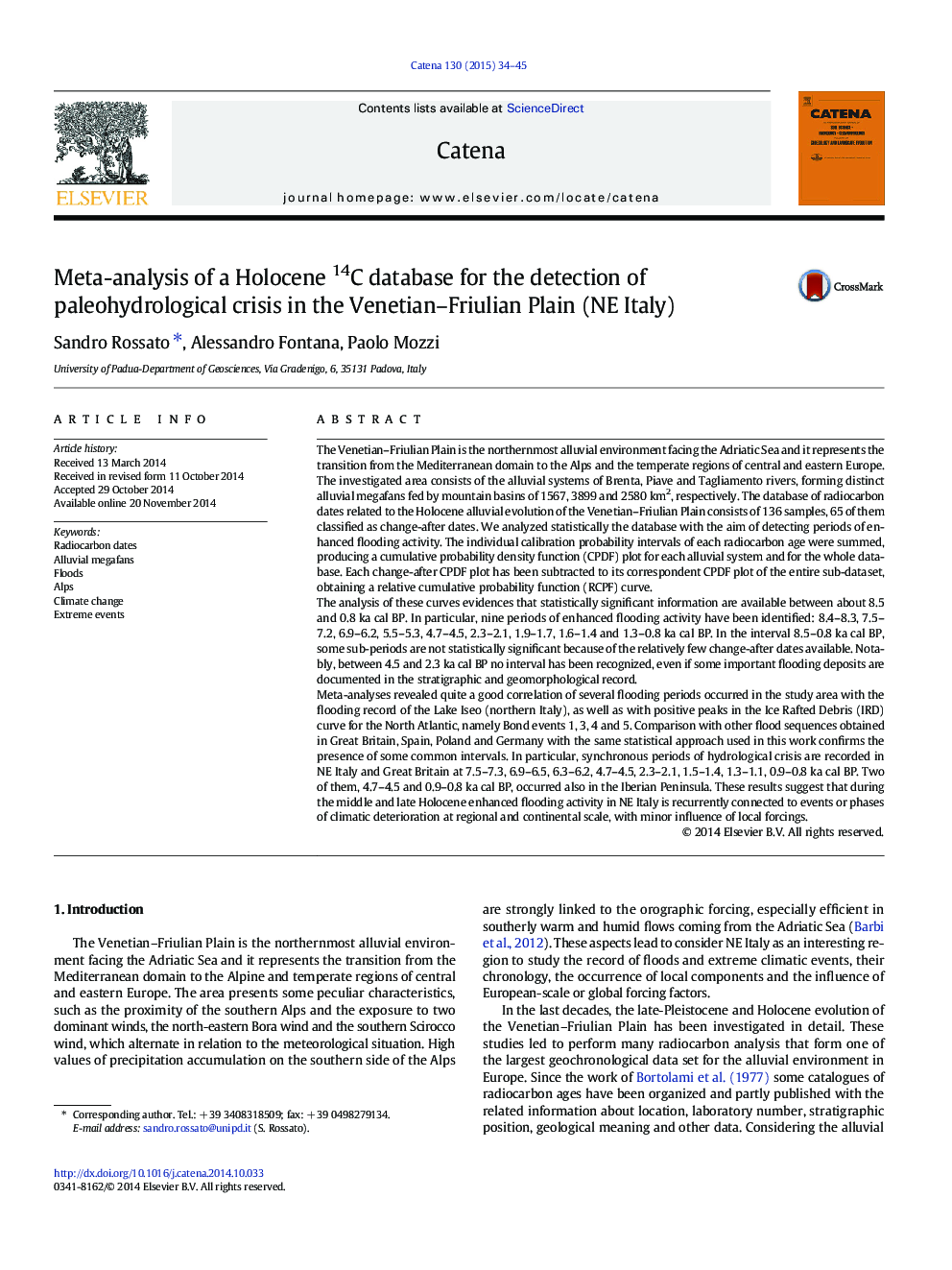| کد مقاله | کد نشریه | سال انتشار | مقاله انگلیسی | نسخه تمام متن |
|---|---|---|---|---|
| 4571146 | 1629222 | 2015 | 12 صفحه PDF | دانلود رایگان |

• First statistical analysis of 14C-dates database for paleofloods detection in Italy
• Strong integration between statistical analysis, stratigraphy and geomorphology
• Middle and late-Holocene flooding periods in NE Italy have been individuated.
• Flooding periods were partially synchronous at European scale.
• Correlations between North-Atlantic and NE Italy climatic fluctuations are evidenced.
The Venetian–Friulian Plain is the northernmost alluvial environment facing the Adriatic Sea and it represents the transition from the Mediterranean domain to the Alps and the temperate regions of central and eastern Europe. The investigated area consists of the alluvial systems of Brenta, Piave and Tagliamento rivers, forming distinct alluvial megafans fed by mountain basins of 1567, 3899 and 2580 km2, respectively. The database of radiocarbon dates related to the Holocene alluvial evolution of the Venetian–Friulian Plain consists of 136 samples, 65 of them classified as change-after dates. We analyzed statistically the database with the aim of detecting periods of enhanced flooding activity. The individual calibration probability intervals of each radiocarbon age were summed, producing a cumulative probability density function (CPDF) plot for each alluvial system and for the whole database. Each change-after CPDF plot has been subtracted to its correspondent CPDF plot of the entire sub-dataset, obtaining a relative cumulative probability function (RCPF) curve.The analysis of these curves evidences that statistically significant information are available between about 8.5 and 0.8 ka cal BP. In particular, nine periods of enhanced flooding activity have been identified: 8.4–8.3, 7.5–7.2, 6.9–6.2, 5.5–5.3, 4.7–4.5, 2.3–2.1, 1.9–1.7, 1.6–1.4 and 1.3–0.8 ka cal BP. In the interval 8.5–0.8 ka cal BP, some sub-periods are not statistically significant because of the relatively few change-after dates available. Notably, between 4.5 and 2.3 ka cal BP no interval has been recognized, even if some important flooding deposits are documented in the stratigraphic and geomorphological record.Meta-analyses revealed quite a good correlation of several flooding periods occurred in the study area with the flooding record of the Lake Iseo (northern Italy), as well as with positive peaks in the Ice Rafted Debris (IRD) curve for the North Atlantic, namely Bond events 1, 3, 4 and 5. Comparison with other flood sequences obtained in Great Britain, Spain, Poland and Germany with the same statistical approach used in this work confirms the presence of some common intervals. In particular, synchronous periods of hydrological crisis are recorded in NE Italy and Great Britain at 7.5–7.3, 6.9–6.5, 6.3–6.2, 4.7–4.5, 2.3–2.1, 1.5–1.4, 1.3–1.1, 0.9–0.8 ka cal BP. Two of them, 4.7–4.5 and 0.9–0.8 ka cal BP, occurred also in the Iberian Peninsula. These results suggest that during the middle and late Holocene enhanced flooding activity in NE Italy is recurrently connected to events or phases of climatic deterioration at regional and continental scale, with minor influence of local forcings.
Journal: CATENA - Volume 130, July 2015, Pages 34–45